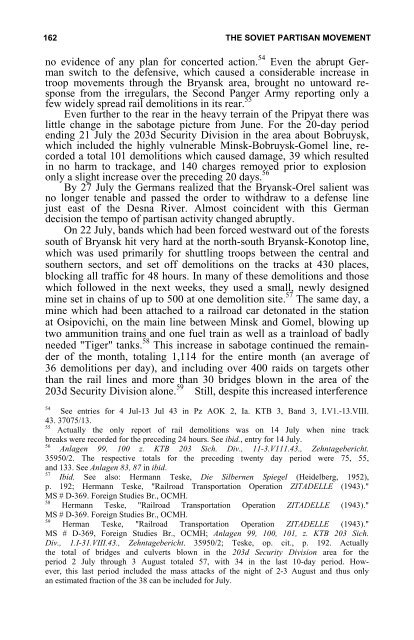the soviet partisan movement 1941-1944 by edgar m. howell
the soviet partisan movement 1941-1944 by edgar m. howell
the soviet partisan movement 1941-1944 by edgar m. howell
You also want an ePaper? Increase the reach of your titles
YUMPU automatically turns print PDFs into web optimized ePapers that Google loves.
162 THE SOVIET PARTISAN MOVEMENT<br />
no evidence of any plan for concerted action. 54 Even <strong>the</strong> abrupt German<br />
switch to <strong>the</strong> defensive, which caused a considerable increase in<br />
troop <strong>movement</strong>s through <strong>the</strong> Bryansk area, brought no untoward response<br />
from <strong>the</strong> irregulars, <strong>the</strong> Second Panzer Army reporting only a<br />
few widely spread rail demolitions in its rear. 55<br />
Even fur<strong>the</strong>r to <strong>the</strong> rear in <strong>the</strong> heavy terrain of <strong>the</strong> Pripyat <strong>the</strong>re was<br />
little change in <strong>the</strong> sabotage picture from June. For <strong>the</strong> 20-day period<br />
ending 21 July <strong>the</strong> 203d Security Division in <strong>the</strong> area about Bobruysk,<br />
which included <strong>the</strong> highly vulnerable Minsk-Bobruysk-Gomel line, recorded<br />
a total 101 demolitions which caused damage, 39 which resulted<br />
in no harm to trackage, and 140 charges removed prior to explosion<br />
only a slight increase over <strong>the</strong> preceding 20 days. 56<br />
By 27 July <strong>the</strong> Germans realized that <strong>the</strong> Bryansk-Orel salient was<br />
no longer tenable and passed <strong>the</strong> order to withdraw to a defense line<br />
just east of <strong>the</strong> Desna River. Almost coincident with this German<br />
decision <strong>the</strong> tempo of <strong>partisan</strong> activity changed abruptly.<br />
On 22 July, bands which had been forced westward out of <strong>the</strong> forests<br />
south of Bryansk hit very hard at <strong>the</strong> north-south Bryansk-Konotop line,<br />
which was used primarily for shuttling troops between <strong>the</strong> central and<br />
sou<strong>the</strong>rn sectors, and set off demolitions on <strong>the</strong> tracks at 430 places,<br />
blocking all traffic for 48 hours. In many of <strong>the</strong>se demolitions and those<br />
which followed in <strong>the</strong> next weeks, <strong>the</strong>y used a small, newly designed<br />
mine set in chains of up to 500 at one demolition site. 57 The same day, a<br />
mine which had been attached to a railroad car detonated in <strong>the</strong> station<br />
at Osipovichi, on <strong>the</strong> main line between Minsk and Gomel, blowing up<br />
two ammunition trains and one fuel train as well as a trainload of badly<br />
needed "Tiger" tanks. 58 This increase in sabotage continued <strong>the</strong> remainder<br />
of <strong>the</strong> month, totaling 1,114 for <strong>the</strong> entire month (an average of<br />
36 demolitions per day), and including over 400 raids on targets o<strong>the</strong>r<br />
than <strong>the</strong> rail lines and more than 30 bridges blown in <strong>the</strong> area of <strong>the</strong><br />
203d Security Division alone. 59 Still, despite this increased interference<br />
54<br />
See entries for 4 Jul-13 Jul 43 in Pz AOK 2, Ia. KTB 3, Band 3, I.V1.-13.VIII.<br />
43. 37075/13.<br />
55<br />
Actually <strong>the</strong> only report of rail demolitions was on 14 July when nine track <br />
breaks were recorded for <strong>the</strong> preceding 24 hours. See ibid., entry for 14 July.<br />
56<br />
Anlagen 99, 100 z. KTB 203 Sich. Div., 11-3.V111.43., Zehntagebericht.<br />
35950/2. The respective totals for <strong>the</strong> preceding twenty day period were 75, 55,<br />
and 133. See Anlagen 83, 87 in ibid.<br />
57<br />
Ibid. See also: Hermann Teske, Die Silbernen Spiegel (Heidelberg, 1952),<br />
p. 192; Hermann Teske, "Railroad Transportation Operation ZITADELLE (1943)."<br />
MS # D-369. Foreign Studies Br., OCMH.<br />
58<br />
Hermann Teske, "Railroad Transportation Operation ZITADELLE (1943)."<br />
MS # D-369. Foreign Studies Br., OCMH.<br />
59<br />
Herman Teske, "Railroad Transportation Operation ZITADELLE (1943)."<br />
MS # D-369, Foreign Studies Br., OCMH; Anlagen 99, 100, 101, z. KTB 203 Sich. <br />
Div., 1.I-31.VIII.43., Zehntagebericht. 35950/2; Teske, op. cit., p. 192. Actually<br />
<strong>the</strong> total of bridges and culverts blown in <strong>the</strong> 203d Security Division area for <strong>the</strong><br />
period 2 July through 3 August totaled 57, with 34 in <strong>the</strong> last 10-day period. However,<br />
this last period included <strong>the</strong> mass attacks of <strong>the</strong> night of 2-3 August and thus only<br />
an estimated fraction of <strong>the</strong> 38 can be included for July.
















